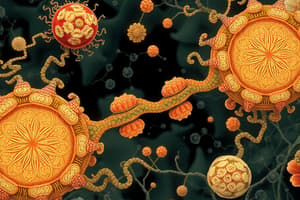Podcast
Questions and Answers
Which class of enzymes catalyzes oxidation-reduction reactions?
Which class of enzymes catalyzes oxidation-reduction reactions?
- Hydrolases
- Transferases
- Lyases
- Oxidoreductases (correct)
What is the primary function of anabolic enzymes?
What is the primary function of anabolic enzymes?
- To transfer functional groups between molecules
- To synthesize complex molecules from simpler ones (correct)
- To break down complex molecules
- To rearrange atoms within a molecule
What is feedback inhibition in metabolic pathways?
What is feedback inhibition in metabolic pathways?
- The transfer of energy from ATP to a substrate
- The breakdown of the end product by an enzyme
- The activation of an enzyme by a substrate
- The inhibition of an earlier enzyme by the end product (correct)
Which of the following is true about allosteric regulation?
Which of the following is true about allosteric regulation?
What type of enzyme is responsible for breaking down molecules without adding water?
What type of enzyme is responsible for breaking down molecules without adding water?
Which mechanism alters enzyme activity through the addition or removal of chemical groups?
Which mechanism alters enzyme activity through the addition or removal of chemical groups?
Which type of enzyme catalyzes the rearrangement of atoms within a molecule?
Which type of enzyme catalyzes the rearrangement of atoms within a molecule?
What defines the process of catabolism?
What defines the process of catabolism?
What type of microorganisms harness energy from sunlight?
What type of microorganisms harness energy from sunlight?
Which process is characterized by the complete breakdown of chemical compounds with the use of oxygen as a final electron acceptor?
Which process is characterized by the complete breakdown of chemical compounds with the use of oxygen as a final electron acceptor?
What kind of microorganisms break down inorganic compounds to obtain energy?
What kind of microorganisms break down inorganic compounds to obtain energy?
During fermentation, what is a key characteristic of the process?
During fermentation, what is a key characteristic of the process?
What role do catabolic enzymes play in microbial metabolism?
What role do catabolic enzymes play in microbial metabolism?
Which group of microorganisms obtains energy by breaking down organic compounds?
Which group of microorganisms obtains energy by breaking down organic compounds?
What distinguishes anaerobic respiration from aerobic respiration?
What distinguishes anaerobic respiration from aerobic respiration?
Which mechanism allows for energy generation through the incomplete breakdown of organic compounds?
Which mechanism allows for energy generation through the incomplete breakdown of organic compounds?
What is the primary purpose of microbial metabolism?
What is the primary purpose of microbial metabolism?
Which of the following correctly describes catabolism?
Which of the following correctly describes catabolism?
What is meant by enzyme compartmentalization in microbial metabolism?
What is meant by enzyme compartmentalization in microbial metabolism?
How do microbes dissipate energy during catabolism?
How do microbes dissipate energy during catabolism?
Which statement best defines anabolism in microbial metabolism?
Which statement best defines anabolism in microbial metabolism?
What is a primary outcome of the catabolic process in microbes?
What is a primary outcome of the catabolic process in microbes?
In what way is microbial metabolic diversity important?
In what way is microbial metabolic diversity important?
Which of the following materials is needed for the lesson on microbial metabolism?
Which of the following materials is needed for the lesson on microbial metabolism?
Flashcards are hidden until you start studying
Study Notes
Microbial Metabolism Overview
- Microbial metabolism encompasses all chemical reactions within microbes for energy and nutrient acquisition, growth, and reproduction.
- It is vital for ecological processes and industrial applications due to the diversity of metabolic strategies.
Key Concepts in Microbial Metabolism
- Catabolism: Breakdown of complex organic molecules into simpler components, releasing energy used for vital functions or dissipated as heat.
- Anabolism: Synthesis of complex structures from simpler organic compounds, requiring energy input.
Energy Acquisition Strategies
- Microorganisms are classified based on their energy acquisition methods:
- Phototrophic Microorganisms: Capture sunlight energy through photosynthesis, converting CO2 into glucose.
- Chemotrophic Microorganisms: Obtain energy through breakdown of organic or inorganic compounds:
- Chemoorganotrophs: Utilize organic compounds.
- Chemolithotrophs: Utilize inorganic compounds.
Energy Sources and Mechanisms
- Respiration or Oxidative Phosphorylation: Complete breakdown of compounds, can be:
- Aerobic Respiration: Uses oxygen as the final electron acceptor.
- Anaerobic Respiration: Uses other elements (nitrate, sulfate, etc.) as final electron acceptors.
- Fermentation: Incomplete breakdown of organic compounds without a final electron acceptor, also known as substrate-level phosphorylation.
Enzymes in Microbial Metabolism
- Enzymes are biological catalysts that facilitate chemical reactions without being consumed:
- Catabolic Enzymes: Break down complex molecules to release energy (e.g., hydrolases, oxidoreductases).
- Anabolic Enzymes: Synthesize complex molecules requiring energy (e.g., ligases, isomerases, transferases).
Regulation of Metabolic Enzymes
- Regulation ensures efficient resource utilization and environmental adaptability:
- Allosteric Regulation: Binding of regulatory molecules at sites different from the active site alters enzyme activity.
- Feedback Inhibition: End products inhibit earlier enzymes in the metabolic pathway, preventing overproduction.
- Covalent Modification: Chemical group addition/removal (e.g., phosphorylation) alters enzyme activity.
Learning Outcomes
- Understand the definition and importance of microbial metabolism.
- Differentiate between catabolism and anabolism.
- Explain enzyme compartmentalization and its regulatory role in metabolism.
Essential Materials
- Module (hard/soft copy)
- Powerpoint presentation
- Whiteboard, markers, laptop, projector
Learning Activity
- Answer questions on microbial metabolism and the difference between anabolism and catabolism on a quarter sheet of paper.
Studying That Suits You
Use AI to generate personalized quizzes and flashcards to suit your learning preferences.




